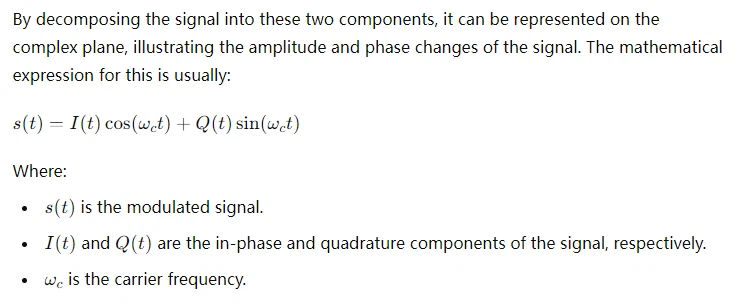What is IQ Modulation?
IQ modulation is a signal modulation technique widely used in modern communication systems, including wireless communication, optical fiber transmission, and radar systems. It achieves efficient transmission of complex data by decomposing a signal into in-phase (I) and quadrature (Q) components, enabling precise control over the signal's amplitude and phase. This technique offers significant advantages in transmission efficiency and interference resistance and serves as the core technology in many communication systems.
Basic Principles of IQ Modulation
IQ Modulation represents a signal using two orthogonal components, known as the I component and the Q component. By modulating these two components separately, it becomes possible to control both the amplitude and phase of a signal precisely. This modulation method uses the concept of complex numbers, viewing the signal as a point on the complex plane, which can effectively represent complex signal variations.
1.1 In-Phase (I) and Quadrature (Q) Components
In-Phase Component (I Component): The part of the signal that is in phase with the carrier wave, representing the real part of the signal.
Quadrature Component (Q Component): The part of the signal that is orthogonal to the carrier wave, representing the imaginary part of the signal.

1.2 Complex Number Representation

Where jjj is the imaginary unit. This representation allows for control of both the phase and amplitude of the signal by adjusting the I and Q values, enabling more complex modulation schemes.
1.3 Vector Representation
IQ modulation can also be depicted using vector representation, where the signal corresponds to a vector on the complex plane. The length of the vector represents the amplitude of the signal, and the angle represents the phase of the signal.
Types of IQ Modulation
The flexibility of IQ modulation allows for various modulation schemes to cater to different communication needs. Here are some common types of IQ modulation:
2.1 Amplitude Shift Keying (ASK)
ASK is a simple modulation method that changes the amplitude of the signal to transmit data. In IQ modulation, this change can be realized by adjusting the amplitudes of the I and Q components. A simple form of ASK is Binary Amplitude Shift Keying (BASK), where the two states of the signal correspond to two different amplitudes.
2.2 Phase Shift Keying (PSK)
PSK modulates the phase of the signal to represent information. In IQ modulation, this can be achieved by simultaneously adjusting the I and Q components. Common types of PSK include Binary Phase Shift Keying (BPSK) and Quadrature Phase Shift Keying (QPSK). QPSK uses four distinct phase states to transmit data, allowing for higher data rates within the same bandwidth.
2.3 Quadrature Amplitude Modulation (QAM)
QAM combines both amplitude and phase modulation to achieve more efficient data transmission. By simultaneously adjusting the amplitudes of I and Q, QAM can transmit more information within limited bandwidth. This technology is commonly used in high-speed communications like DSL and Wi-Fi standards.
2.4 Frequency Shift Keying (FSK)
FSK modulates the frequency of the carrier to represent different digital signal states. IQ modulation can realize more complex frequency conversions, such as Minimum Shift Keying (MSK), widely used in radio communications.





